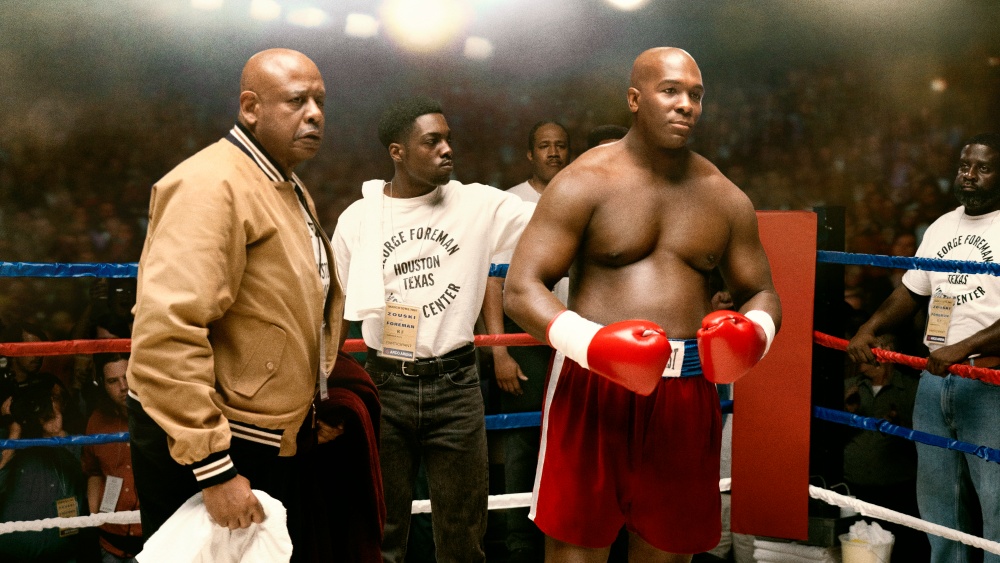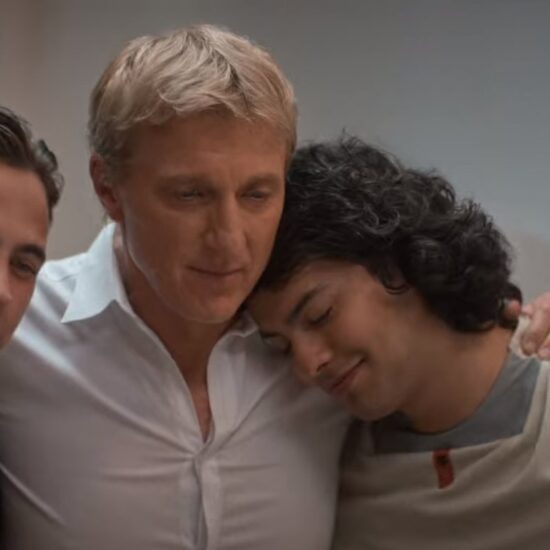
Biopics about star athletes or artists tend to have the same broad shape: the rise to achievement and fame, the fall from triumph (often fueled by some combination of addiction and ego), the restoration to a harder-won glory. A great biopic, like “Get on Up” or “I, Tonya,” will tease a profound portrait of the subject out of that form; a middling one will oversimplify the subject just to hit the right beats. But then there’s a film like “Big George Foreman: The Miraculous Story of the Once and Future Heavyweight Champion of the World.” That’s not a movie title — it’s the title of a parable. And it’s well chosen, since “Big George Foreman” is about a life that feels so outlandishly ready-made for the ups and downs, the lessons and inspirations, of the superstar biopic genre that you don’t even have to mess with it. The real George Foreman has, in effect, already scripted it for you.
Directed and co-written by George Tillman Jr., who made the sensationally accomplished and moving “The Hate U Give” as well as the terrific, overlooked Biggie Smalls biopic “Notorious,” “Big George Foreman” is a boxing movie that turns into a faith-based movie, until it becomes both. Is it an honest biopic? More so than not. Is it a rich and revealing portrait of George Foreman? It’s prosaic and conventional and a touch stolid, but it stays true to the facts and the spirit of the man (he’s both sinner and saint), and the saga they add up to is singular in the history of sports.
This is the story of a boxer who, even when considered next to the world’s most awesome power punchers, had a hook that packed an annihilating force. The film asks where that force came from, and its answer, in a matter-of-fact way, is anger. “Big George Foreman” recognizes that boxing, at its greatest, exists on a level of genius (it’s not a glorified street fight), yet the movie is quite upfront about the drive that powered a boxer like Foreman. In the scenes where he’s a teenage kid (played by Austin David Jones) in Houston, we see the poverty he grew up in (his family slices a hamburger into four quarters, and at lunchtime he’s the only student who can’t afford to bring lunch), and the way he’s humiliated for his meager trappings evokes a primal resentment in him that fuels his beating up of the kids who would tease him.
To say that there’s a link between boxing and rage is to state a blunt reality. It’s no accident that the greatest boxing movie ever made is called “Raging Bull.” Yet not every champion boxer is a raging bull. The Foreman we see is one, and Khris Davis, the dynamic actor who plays him with a chiseled stare of cold fury, makes you see that the young and aimless George, who joins the paramilitary Job Corps in the mid-’60s, already views himself the way the young Malcolm X did, as a Black man who’s “angry” only in response to the wrongs that have been done to him. They have a way of adding up. In the Job Corps barracks in Pleasanton, Ca., when George spies the recruit who stole the Converse sneakers his mother sent him, he’s ready to pummel him into oblivion. And we see why; it’s an insult added to a thousand injuries.
Foreman just about gets himself kicked out of the Corps, but he’s rescued by Doc Broadus (Forest Whitaker, intensely winning, speaking in a voice of the purest lived-in gravel), an officer who runs a boxers’ training camp on the premises. George takes to the ring as if born to it — not just the punching but the discipline of it all, the jump-roping and the repetitions. The year is 1967, and Doc tells him that he should aim to try for the American Olympic boxing team in five years. Upon hearing that, George, with his feral scowl, looks like he wants to beat up Doc. The film cuts to one year later, when he has gotten himself into the 1968 Olympic Games in Mexico City, with just a year of training.
That, of course, was the Olympics that yielded the iconic moment when the Black American track stars Tommie Smith and John Carlos, during their medal ceremony, stood with their black-gloved fists raised. When George, by contrast, wins by a TKO over the Soviet boxer Iones Chepulis to take the gold medal, he’s handed a small American flag, which he waves around in the ring. When he gets back to the States, that’s all the folks in his Houston neighborhood are talking about — that George sold out, embracing America when he should have adopted a more revolutionary stance. Talk about a motive for anger! But George doesn’t let it throw him. He channels that rage into the ring, scaling the mountain toward the heavyweight championship by destroying one fighter after the next, until he gets his title bout, facing off against Joe Frazier (Carlos Takam).
You could say that the rest is history. Foreman defeated Frazier. Howard Cosell, played here by Matthew Glave, went apoplectic shouting “Frazier is down! Frazier is down! Frazier is down!” (though I wish the film had included the less famous Cosell line “It’s target practice for George Foreman!”). The truth is that the fights in “Big George Foreman,” from that title bout to Foreman’s Rumble in the Jungle match-up against Muhammad Ali in Zaire in 1974 to his loss against Jimmy Young in 1977, are so iconic that the film can’t pretend to invest them with some cataclysmic suspense. Sullivan Jones, the actor who plays Ali, tries hard, but you feel how hard he’s trying, because he’s miscast. He lacks Ali’s moonstruck Dionysian quality; he’s more like Ali as a lawyer.
For a while, George Foreman was on top of the world (until Ali defeated him), but you could say that the real drama of “Big George Foreman” begins after that. George, in addition to being an angry fighter, is a sinner in his personal life. He meets and marries the sexy and supportive Paula (Shein Mompremier), only to take her for granted and fool around behind her back. And he pays the price. His domestic life collapses; his boxing life fades; he has a near-death experience after Jimmy Young pummels him. George’s mother, Nancy (Sonja Sohn), a conservative Christian lady who has never liked boxing, has been telling him through the entire movie to honor a higher power. And now, with death looking him in the face, he does. He bounces back and embraces Jesus. He gets himself baptized and becomes an ordained minister.
The George we’ve known isn’t such a talker, but the gift of gab — his transformation into the smiling, big-daddy George Foreman we now know — will come upon him. It’s a shift in his spirit. The letting go of the rage.
This is not the stuff of a boxing movie. It’s a conversion narrative, the story of an addict’s redemption. And watching it, it has a bit of that slightly bland I’ve-seen-the-light piety that makes me less than ecstatic about so many faith-based movies. (It’s not that I don’t like faith; I just don’t like seeing faith turned into Hallmark propaganda.) But “Big George Foreman” has a last act, provided by history, that’s something of a killer. George, having been knocked down by life, gets even more knocked down by his finances. He entrusted them to Des (John Magaro), his flaky alcoholic bunkmate from the Job Corps, and the result is that after setting up a Youth Center in Houston, marrying the devout Mary Joan (Jasmine Matthews) and settling comfortably into his retirement, he discovers that he’s broke.
There’s only thing left for him to do — and no, I’m not talking about the George Foreman Grill (though that does merit a mention). George will go back into the ring. When he’s 38. After having been away from boxing for 10 years. Now looking less like Superman than (as the movie jokes) like the Michelin Man. (He’s 315 pounds and needs to get down to 265.) He’s well past the point when any boxer who is sane has ever gotten back into the ring. But he will do something extraordinary. He will win. Again and again.
Because he’s feeling the old rage? No. Because he’s connecting with the boxing force that grew out of the rage and is attaching itself to a higher impulse: the desire to save (himself). He might still be a raging bull, but he’s now a transcendent bull. And this, of course, all really happened. George Foreman, in one of the most singular stories in the history of sports, became, at 45, the oldest man ever to win the heavyweight championship. “Big George Foreman” takes you just far enough inside that journey, that coup, to become a sports biopic of appealing urgency. The film has a conventional heart, yet it’s about a victory we share as if it were our own.













